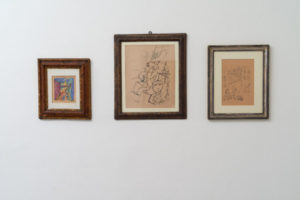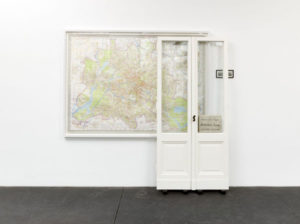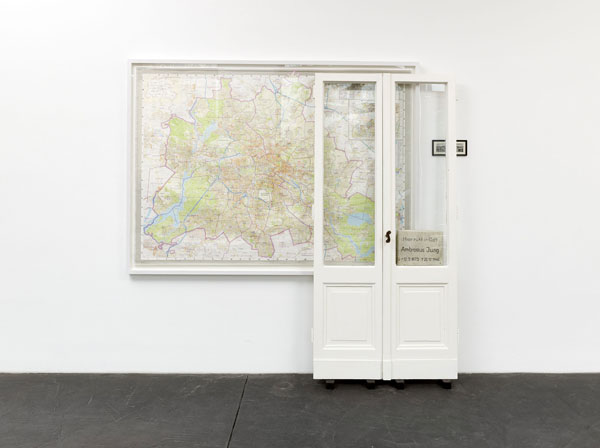Galleria de’ Foscherari presents Berlin 192010, a project by Luca Vitone that compares the image of the German capital under the Weimar Republic with that of the period of the unified Federal Republic after the falling of the wall.
The city, that during the post-war world era became a hub of international creativity, is narrated by a valuable collection of works by George Grosz, while the change that took place since the falling of the wall is addressed with a series of works made by the artist from Genoa who decided to settle in the capital of Germany after many residences there.
His artistic practice, which comes from the intersection of personal and collective memory and the dialectical relationship with the archive of the past, has always focused on the idea of re-cognition that challenges cultural conventions in a route open to possible answers that raise new questions. Libertarian socialism that during the 90s has turned Berlin in a spread laboratory of all that is cultural research, calling for the second time creative personalities from different contexts, seems to reveal today a coercive matrix which partially contradicts the utopia of a truly alternative proposal. It rises the doubt that the multifaceted German openness who claimed the most radical experiments and who postulated a society aware of the autonomy and individual freedom of its citizens could be nothing more than an official image. The artist, after idealizing Germany up to the point of choosing it as his adopted country, doubts whether or not the supposed knowledge of the German people could be the result of an accepted imposition that relegates the protest in established places and moments. Vitone’s work has always focused on creating an alternative artistic semantic that brings to the surface the implicit signs of the places of which he plumbs the dark side, as it happened, for example, in Bologna in 2014 for the exhibition ON when he installed in a very busy street of the city five lights with Masonic symbols on them to remember the tragedy of the massacre at the station in 1980 and to recall the persistence of ramifications of the P2 lodge in Italy in the last twenty years. Or as it happened with To Eternity, the invisible sculpture presented at the Venice Biennale in 2013, where the essence of rhubarb that hovered in the Italian Pavilion recalled the unwitting inhalation of Eternit dust by those who have lived or worked in contact with this highly toxic substance.
According to the emblematic simplicity of his language and in order to be a witness of his time through the continuous comparison between himself and the world around him, the artist for the exhibition Berlin 192010 collects maps, magazines and objects from his daily life flanked by the colors of the national flag and other elements that allude to German culture. The theme of this presentation is provided by windows taken from his private home that appear obscured by black, red and yellow backgrounds or become diaphragms through which it’s possible to watch a conceptualized panorama of Berlin made by topographic maps and engravings of different periods and styles. It goes from the supposed neutrality of a school map, to another one where the tourist icons of bars and restaurants are more noticeable than the ones that distinguish monuments, to an ancient printing published in a newspaper that represents an idealized city exclusively made by its representative buildings. The link between these abstract representations of the urban fabric and the plot of personal and collective stories that produced them consists of the items that appear in each installation: a toy, a toppled bouquet of roses or a marble plaque that Vitone found in his Berlin apartment when he moved there. The name of the deceased, Ambrosius Jung, evokes the father of analytical psychology and, at the same time, the German word that means youth, while his dates of birth and death (1875-1946) are fatally next to the dawn of National Socialism and the end of Second World War. If the tombstone of this stranger seems an implicit commemoration of mad humanity that writhes in paintings by George Grosz, Vitone dedicates a personal epitaph to the Berlin of his youth through a video where he crosses by bike the eastern part of the city focusing on details representing change. From sunrise to sunset he crosses crowded or deserted streets humming a distorted version of the International in which he replaces the original words with the names of the commercial activities he meets along his journey. This provocative juxtaposition suggests that ideologies and regimes of the past share with the globalized policies of our contemporary the intention of creating an artificial order capable of establishing a restrained co-existence within human beings. But, as history shows, it is always a fictitious attempt and the imponderable explodes unexpectedly even when there seems to be no possibility of deviation as in the installation of three bicycles intended to constantly run in circles around a plant of chrysanthemums laid on a wedding tablecloth.
Luca Vitone – Berlin 192010
31 October 2015 – 19 February 2016
Galleria de’ Foscherari, Via Castiglione 2/b Bologna
 Luca Vitone, Berlin 192010. Installation view, Galleria de’ Foscherari, 2015
Luca Vitone, Berlin 192010. Installation view, Galleria de’ Foscherari, 2015
 Luca Vitone, Berlin 192010. Installation view, Galleria de’ Foscherari, 2015
Luca Vitone, Berlin 192010. Installation view, Galleria de’ Foscherari, 2015
 Luca Vitone, Berlin 192010. Installation view, Galleria de’ Foscherari, 2015
Luca Vitone, Berlin 192010. Installation view, Galleria de’ Foscherari, 2015
 Luca Vitone, Berlin 192010. Installation view, Galleria de’ Foscherari, 2015
Luca Vitone, Berlin 192010. Installation view, Galleria de’ Foscherari, 2015
Graduated in art history at DAMS in Bologna, city where she continued to live and work, she specialized in Siena with Enrico Crispolti. Curious and attentive to the becoming of the contemporary, she believes in the power of art to make life more interesting and she loves to explore its latest trends through dialogue with artists, curators and gallery owners. She considers writing a form of reasoning and analysis that reconstructs the connection between the artist’s creative path and the surrounding context.







NO COMMENT